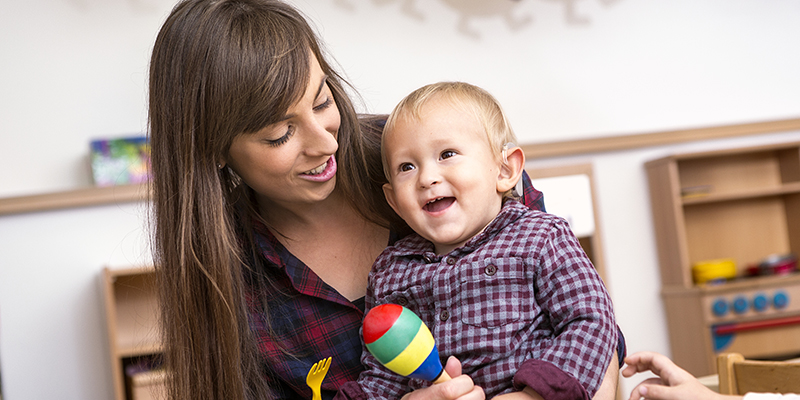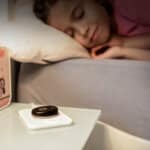Singing Rhymes With Daily Activities

“Listening comprehension precedes reading comprehension”, Mr. Stead said. In order for a child to understand what they are reading, they have to be able to hear and understand spoken language first. A lot of the traditional rhymes, such as ‘Jack and Jill’ and ‘Humpty Dumpty’ contain repetition. The repeated language makes it easy for children to remember words and how they go together.
Learning songs and rhymes is important for children with hearing loss not only for developing language skills but also thinking skills, physical and social and emotional maturity and even early literacy skills.
Why Are Songs And Rhymes So Important For Children With Hearing Loss?
- When children listen to nursery rhymes, they hear the sounds vowels and consonants make. They learn how to put these sounds together to make words. Nursery rhymes sometimes highlight specific sounds by using alliteration (e.g., Goosey Goosey Gander). This helps children with hearing loss develop their awareness of the sounds within words. This skill is called Phonological Awareness and it is important for learning to read.
- When children sing nursery rhymes, they practice pitch, volume, and voice inflection, as well as the rhythm of language. Songs and rhymes are helpful for children with hearing loss to develop control of these suprasegmental aspects of speech.
- Rhymes and songs introduce children to words and more complex sentences that may not be used in everyday speech. Rhymes pair repetitive language with an enjoyable melody, helping the brain to remember new words, word endings and sentence structures.
- Singing song and rhymes can help with sequencing and auditory memory. Songs and rhymes usually tell a story with a beginning, a middle, and an end. This teaches children that events happen in sequence, and they begin to learn how to understand stories and follow along. As children practice the same songs over and over, they practice recalling longer strings of information and learn the order in which they go together. This will help to extend their auditory memory. Sequencing and auditory memory are important skills for telling stories and reading comprehension.
- Many children with hearing loss exhibit delays in Theory of Mind (ToM). The foundation of ToM is hearing early conversations containing mental state words that describe thoughts, feelings and beliefs. Characters in songs and rhymes experience many different emotions. This can help children with hearing loss learn mental state words and develop their understanding of the emotions and behaviors of others.
You can sing rhymes to promote a child’s listening and language skills anywhere. The best part of this is that you don’t need any toys, resources or devices. Singing lullabies while cuddling and rocking rhythmically will allow your child to become familiar with your voice and the rhythm of your language.
However, it can be hard to think of lots of different songs and how you can use them throughout your day. So, I will give you some examples of songs and rhymes you can sing as you go about your daily activities with your child. Included are links to songs on YouTube for you to become familiar with the lyrics and melody of the suggested songs. We don’t recommend that your child watch the videos, but that you incorporate singing of the songs into your daily activities. These are just suggestions; you can use any children’s songs and rhymes that you know.
Morning Activities
Good Morning Song
Activity: Waking Up
Lyrics: Good morning, good morning. Hello, and how are you?
Can’t See This Video?
Having problems viewing this video? Watch it on YouTube.
This is the Way
Activity: Wash my face
Lyrics: This is the way we wash our face, wash our face, wash our face. This is the way we wash our face. Early in the morning.
Can’t See This Video?
Having problems viewing this video? Watch it on YouTube.
Sitting on the Potty
Activity: Potty time
Lyrics: Look at me. Sitting on the potty. Tweedly dee. Sitting on the potty.
Poo Poo Song
Activity: Potty time
Lyrics: When you need to pee-pee, When you need to pee-pee, go to the bathroom. Go, go, go!
Can’t See This Video?
Having problems viewing this video? Watch it on YouTube.
Yes,Yes Vegetables Song
Activity: Mealtime
Lyrics: Peas, peas, it’s time to eat your peas! Yes, yes, yes, I want to eat my peas!
Can’t See This Video?
Having problems viewing this video? Watch it on YouTube.
Afternoon Activities
Peek-a-boo
Activity: Playtime
Lyrics: Peekaboo! Peekaboo! Peekaboo! Peekaboo! Peekaboo! Peekaboo! I see you!
Can’t See This Video?
Having problems viewing this video? Watch it on YouTube.
Wheels on the Bus
Activity: Playtime
Lyrics: The wheels on the bus go round and round. Round and round. Round and round.
Can’t See This Video?
Having problems viewing this video? Watch it on YouTube.
Head and Shoulders, Knees and Toes
Activity: Playtime
Lyrics: Head, shoulders, knees, and toes, knees and toes.
Can’t See This Video?
Having problems viewing this video? Watch it on YouTube.
Hickory Dickory Dock
Activity: Playtime
Lyrics: Hickory dickory dock. The mouse went up the clock. The clock struck one. The mouse went down.
Can’t See This Video?
Having problems viewing this video? Watch it on YouTube.
Yes, Yes Playground
Activity: At the playground
Lyrics: Shoes, shoes, it’s time to wear your shoes. Yes, yes, yes, I want to wear my shoes.
Can’t See This Video?
Having problems viewing this video? Watch it on YouTube.
Hello Song
Activity: Meeting friends
Lyrics: Hello, hello, hello, hello, hello Nice to meet you.
Can’t See This Video?
Having problems viewing this video? Watch it on YouTube.
Clean Up Song
Activity: Cleaning up
Lyrics: Clean up, clean up. Everybody let’s clean up. Clean up, clean up. Put your things away.
Can’t See This Video?
Having problems viewing this video? Watch it on YouTube.
Goodbye Song for Kids
Activity: Going home
Lyrics: It’s time to go home (3x). It’s time to say “Goodbye”.
Can’t See This Video?
Having problems viewing this video? Watch it on YouTube.
Evening Activities
Bath Song
Activity: Take a bath
Lyrics: I jump in the bathtub, it’s time to get all clean.
Can’t See This Video?
Having problems viewing this video? Watch it on YouTube.
Twinkle, Twinkle, Little Star
Activity: Go to bed
Lyrics: Twinkle, twinkle, little star. How I wonder what you are.
Can’t See This Video?
Having problems viewing this video? Watch it on YouTube.
Repeating these songs every time you do daily activities with your child is a great way to help your child learn a wide variety of rhymes.
Singing Rhymes with Babies and Toddlers
To help your child become familiar with these songs try using the ‘Auditory Sandwich’.
- First, sing the nursery rhyme with voice only a couple of times.
- Second, sing the nursery rhyme with related toys or add associated hand motion sequences.
- Third, sing the nursery rhyme with voice only one more time.
For example, before your child goes to bed, sing ‘Twinkle, Twinkle, Little Star’ with voice only. Then sing the song again once your child is in bed with the actions. And then sing the song with voice only when your child is about to fall asleep.
Singing Rhymes with Children
To support your child to begin to participate in songs, use ‘Auditory Closure’.
- Sing the nursery rhyme to your child every day to help your child to become familiar with the song.
- Sing the nursery rhyme, and then pause before the last word or a fun sound.
- Look expectantly at your child to encourage them to fill in the gap. Depending on your child’s age and stage, they might use an associated action, make a sound, or fill in the next word or phrase.
For example, sing Wheels on the Bus every time you play with a bus toy, see or travel on a bus. Once your child is familiar with the song, sing ‘The wheels on the bus go round and round. Round and round. Round and …..’ Pause and look expectantly at your child to encourage them to fill in the gap.
Looking for more fun rehab activities that you can do at home? The “Whale Go Fish” game is a great way to help develop your child’s listening, speech, and language skills.
Thanks for your message. We will reply as soon as possible.
Send us a message
Field is required
John Doe
Field is required
name@mail.com
Field is required
What do you think?
© MED-EL Medical Electronics. All rights reserved. The content on this website is for general informational purposes only and should not be taken as medical advice. Contact your doctor or hearing specialist to learn what type of hearing solution suits your specific needs. Not all products, features, or indications are approved in all countries.


